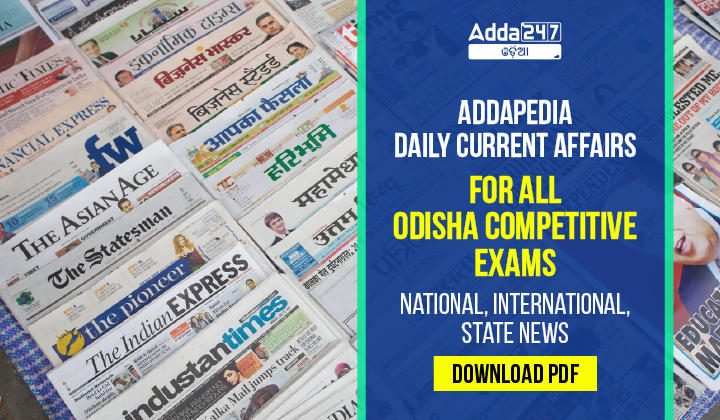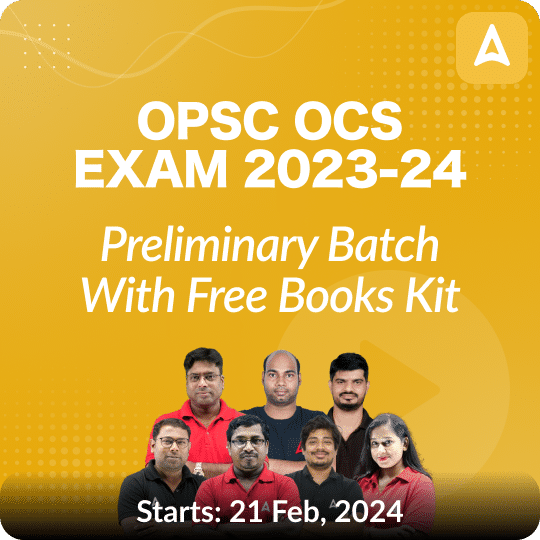As you are aware, in all competitive exams, the “Daily Current Affairs Section” holds significant importance in determining the cutoff scores. Therefore, if you excel in this section, you will have a better chance of achieving higher marks in these exams and securing a spot on the merit list.
Addapedia Odisha – Daily Current Affairs – 17 April 2024
| National and International News |
| ISRO’s Innovative Approach to Zero Orbital Debris |
Context:
- ISRO’s PSLV-C58/XPoSat mission has achieved a remarkable feat by leaving virtually no debris in Earth’s orbit.
- This achievement is attributed to the innovative use of the PSLV Orbital Experimental Module (POEM), developed by the Vikram Sarabhai Space Centre (VSSC).
POEM:
- POEM is powered by solar panels and a lithium-ion battery mounted on the fuel tank of the rocket’s fourth stage.
- It is equipped with a dedicated navigation, guidance, and control (NGC) system, including four Sun sensors, a magnetometer, and gyroscopes, which communicate with ISRO’s NavIC satellite constellation for navigation.
- POEM also features helium control thrusters and a telecommand system for ground station communication.
Key points:
-
- This achievement is significant due to the escalating issue of space debris, particularly in low Earth orbit (LEO).
- LEO debris consists of spacecraft fragments, rockets, defunct satellites, and fragments from anti-satellite missile tests, posing risks to operational satellites.
- ISRO’s Space Situational Assessment report 2022 noted a significant increase in the number of objects placed in space, highlighting the urgent need for effective debris mitigation strategies.
Concerned Laws:
- While there are no international laws specific to LEO debris, most space-faring nations adhere to the Space Debris Mitigation Guidelines 2002 set by the Inter-Agency Space Debris Coordination Committee (IADC), endorsed by the U.N. in 2007.
- Aim:to reduce accidental collisions, break-ups during operations, intentional destruction, and post-mission break-ups.
- They discourage the long-term presence of spacecraft and launch vehicle orbital stages in LEO and limit their impact on the geosynchronous orbit (GEO).
Various initiatives:
- Various space agencies have implemented strategies to address space debris.
- NASA’s Orbital Debris Program, initiated in 1979, focuses on reducing orbital debris and developing technologies for tracking and removing existing debris.
- The European Space Agency (ESA) has adopted a ‘Zero Debris charter,’ aiming for zero space debris by 2030 and advocating for its adoption by other agencies.
- Japan’s Commercial Removal of Debris Demonstration (CRD2) project is another effort to tackle the issue of space junk.
|
| Right to sleep |
Context:
- The Bombay High Court rejected a plea from a 64-year-old businessman regarding his arrest by the Enforcement Directorate (ED), criticizing the ED for making him wait overnight and recording his statement, thereby depriving him of the ‘right to sleep’ under Article 21 of the Constitution.
Key points:
- The court emphasized that the ‘right to sleep’ is a fundamental human need and depriving someone of it violates their human rights, affecting their health and cognitive skills.
- It directed the agency to issue guidelines on the timings for recording statements under Section 50 of the Prevention of Money Laundering Act (PMLA).
|
| Credit-Deposit Ratio
|
Context:
- The March 2024 report by CareEdge highlighted that banks’ credit-deposit (CD) ratio has reached a decadal high, standing at around 80 percent.
- This ratio reflects the percentage of deposits banks have raised that have been lent out, indicating liquidity and credit risks for banks.
About:
- The currency deposit ratio, on the other hand, reveals the proportion of currency that individuals hold compared to aggregate deposits.
- When the cash deposit ratio increases, the money multiplier decreases.
- Similarly, an increase in deposit rates encourages depositors to deposit more, reducing the Cash to Aggregate Deposit ratio and increasing the Money Multiplier.
|
| Jiadhal River |
Context:
- The Jiadhal River, a tributary of the Brahmaputra River in northern India, is facing the adverse effects of climate change, disrupting its once tranquil flow.
Key points:
- Originating in the sub-Himalayan mountains of Arunachal Pradesh at an altitude of 1247m, the river courses through a narrow gorge in Arunachal Pradesh before entering the plains of Assam’s Dhemaji district, where it flows in braided channels.
- It finally meets the Brahmaputra near Selamukh in Lakhimpur district.
- However, due to the construction of an embankment over the Kherkutiya Suti of the Brahmaputra, the river now merges with the Subansiri River.
- Spanning a total length of 187 km, the river’s topography transitions from hilly terrain in the upper basin (Himalayan range) to a plain area in the middle and downstream.
- The Jiadhal River’s catchment area covers 1053.20 sq.km., with 696.80 sq.km. in Assam and 356.4 sq.km. in Arunachal Pradesh.
- It receives heavy rainfall, leading to a significant silt load from its 1346 sq. km catchment area during the rainy season.
- This results in the considerable rise of its riverbed as the silt deposits on its bed in the plains.
- Known for its frequent course changes and devastating floods, the Jiadhal River exemplifies a flashy river, causing floods with a sudden, high discharge over a short time (a few hours to a day) and carrying a high sediment load and debris.
|
| Operation Meghdoot |
Context:
- The Indian Army commemorated 40 years of ‘Operation Meghdoot’ on the Siachen Glacier, a milestone in its strategic presence there.
- This operation has seen significant technological and logistical advancements.
Operation Meghdoot’s History:
-
- Launched on April 13, 1984, by the Indian Army and Indian Air Force (IAF), it marked a pivotal moment in securing the strategically crucial region dominating Northern Ladakh.
- IAF helicopters had been operating in the area since 1978, including the first landing of an IAF helicopter on the glacier in October 1978.
Operation Meghdoot’s Unique Significance:
-
- Launched in 1984, ‘Operation Meghdoot’ secured the Siachen Glacier, involving the first assault on the world’s highest battlefield.
- Indian troops gained control of the entire Siachen Glacier as a result of this operation.
- The Siachen Glacier now boasts state-of-the-art medical infrastructure, including telemedicine nodes established by ISRO.
- The Indian Army acknowledged the sacrifices of its brave soldiers and the immortal spirit that characterizes its long deployment in Siachen.
Improved Living Conditions and Connectivity:
- Recent initiatives have focused on improving connectivity, leading to advancements in the supply chain.
- This ensures that personnel stationed at forward posts in the Northern and Central Glaciers now have access to fresh rations and vegetables.
- The use of heavy-lift helicopters and logistic drones has significantly improved the supply of essential resources to personnel stationed at isolated posts, especially during harsh winter conditions.
|
| Odisha Regional Specific News |
| Tribal paintings adorn polling booths in Odisha’s Gajapati |
Context:
- The Gajapati district administration in Odisha has creatively decorated polling booths with tribal paintings to celebrate the democratic process among tribal communities.
- This initiative aims to make the elections more engaging for the Souras, a particularly vulnerable tribal group (PVTG) in Odisha.
About:
- The Saura and Lanjia Soura communities are known for adorning their homes and villages with murals during festivals and ceremonies, such as marriages.
- The Sora (alternative names and spellings include Saora, Saura, Savara and Sabara) are a Munda ethnic group from eastern India.
- They live in southern Odisha and north coastal Andhra Pradesh.
- Lanjia Sora woman in traditional jewelry in Rayagada district, Odisha, India.
- The idital, ceremonial paintings done in honor of various deities are the main feature of their religion.
|
| AIIMS-Bhubaneswar |
Context:
- AIIMS-Bhubaneswar has introduced a state-of-the-art service for the placement of Artificial Urinary Sphincters (AUS), marking a significant advancement in urological care.
- This innovative service aims to enhance the quality of life for patients suffering from severe urinary incontinence.
Key points:
- The AUS implantation procedure is considered a gold standard treatment for urinary incontinence that has not responded to traditional therapies. This service is specifically designed for patients who have developed urinary incontinence due to factors such as prostate surgery, spinal cord injuries, or other conditions affecting urinary control.
|
| Bhitarkanika National Park |
Context:
The Bhitarkanika National Park authorities have implemented various measures to protect wildlife from threats such as heatwaves, poaching, and fires.
Key points:
- Forest Department has renovated existing ponds and ditches in the Bhitarkanika forest block to ensure an adequate water supply for hoofed animals and wild boars.
- Additionally, measures have been taken at the Dangamal Crocodile Research Centre to create a better cooling environment for nearly a hundred crocodile hatchlings housed at the hatchery.
Bhitarkanika National Park:
- Bhitarkanika National Park, located in the Kendrapara district of Odisha, is India’s second-largest mangrove ecosystem, following the Sunderbans.
- Designated as a national park on September 16, 1998, it received Ramsar site status in August 2002, becoming the state’s second Ramsar site after Chilika Lake.
- Spanning 145 square kilometers, this park is characterized by a network of creeks and canals, which are fed by the Brahmani, Baitarani, Dhamra, and Patasala rivers, creating a unique ecosystem.
- The flora of Bhitarkanika National Park includes mangrove species, casuarinas, and grasses like the indigo bush.
- In terms of fauna, the park is renowned for its large population of endangered saltwater crocodiles.
- Additionally, the Gahirmatha Beach, forming the park’s eastern boundary, hosts the largest colony of Olive Ridley Sea Turtles.
- Other mammals found in the park include monkeys, jackals, common langurs, otters, sambar deer, jungle cats, foxes, mongooses, wolves, fishing cats, and hyenas.
|
| World Haemophilia Day |
Context:
- World Hemophilia Day is observed annually on April 17th.
- It raises awareness about hemophilia and other bleeding disorders.
Key Points:
- Increase understanding: Educate the public about hemophilia, a genetic condition affecting blood clotting.
- Improve diagnosis and care: Advocate for better access to diagnosis and treatment for all, regardless of location or resources.
- Support the community: Celebrate the strength and resilience of those living with bleeding disorders.
About:
- World Haemophilia Day was started by the World Federation of Haemophilia in 1989
- April 17 was decided as the date to observe the health day every year to honour the founder of the organization Frank Schnabel, who played a significant role in advocating for hemophilia awareness and treatment and dedicated his life towards improving lives of those suffering from the disorder
Theme:
- The theme for this year’s World Haemophilia Day is, ‘Equitable access for all: recognising all bleeding disorders.’
- The main idea of this theme is to make sure everyone gets treated, no matter what type of bleeding problem they have, how old they are, where they live or their gender.
|
| Copyright © by Adda247
All rights are reserved. No part of this document may be reproduced, stored in a retrieval system or transmitted in any form or by any means, electronic, mechanical, photocopying, recording or otherwise, without prior permission of Adda247. |














